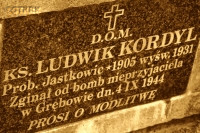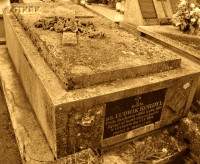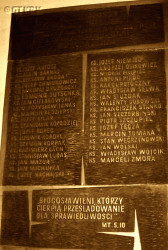Roman Catholic
St Sigismund parish
05-507 Słomczyn
85 Wiślana Str.
Konstancin deanery
Warsaw archdiocese, Poland
full list:
displayClick to display full list

searchClick to search full list by categories
wyświetlKliknij by wyświetlić pełną listę po polsku

szukajKliknij by przeszukać listę wg kategorii po polsku

Martyrology of the clergy — Poland
XX century (1914 – 1989)
personal data

surname
KORDYL
forename(s)
Louis (pl. Ludwik)
function
diocesan priest
creed
Latin (Roman Catholic) Church RCmore on
en.wikipedia.org
[access: 2014.09.21]
diocese / province
Przemyśl diocesemore on
www.przemyska.pl
[access: 2013.02.15]
date and place
of death
04.09.1944

Grębówtoday: Grębów gm., Tarnobrzeg pov., Subcarpathia voiv., Poland
more on
en.wikipedia.org
[access: 2021.10.09]
details of death
After German and Russian invasion of Poland in 09.1939 and start of the World War II arrested for the first time by the Germans in 06.1943 and incarcerated in Budzyń Lubelski slave labour camp.
After a month on 10.07.1943 moved to Zamość camp (prob. in UWZ Lager Zamość transit camp or DL Zamosc (Rotunda) transit camp).
Released on 14.08.1943.
In danger of exposure for working with the resistance Home Army AK (part of Polish Clandestine State), persecuted by the followers of the Polish national church, the Germans and the partisans of Communist People's Army AL operating from a near Janów Forests, on c. 12.03.1944 left his Jastkowice parish and crossed to the left bank of San river.
Settled in a nearby Grębów parish.
Perished from a shrapnel explosion by the Grębów vicarage, during bombardment by prob. Russian advancing troops.
cause of death
warfare
perpetrators
Germans / Russians
sites and events
DL ZamoscClick to display the description, GeneralgouvernementClick to display the description, Ribbentrop‐MolotovClick to display the description, Pius XI's encyclicalsClick to display the description
date and place
of birth
12.08.1905

Gorlicetoday: Gorlice gm., Gorlice pov., Lesser Poland voiv., Poland
more on
en.wikipedia.org
[access: 2021.04.01]
presbyter (holy orders)
ordination
30.05.1931

Przemyśltoday: Przemyśl city pov., Subcarpathia voiv., Poland
more on
en.wikipedia.org
[access: 2021.04.01]
Assumption of the Blessed Virgin Mary and St John the Baptist RC cathedral churchmore on
en.wikipedia.org
[access: 2025.03.14]
positions held
1935 – 1944
parish priest — Jastkowicetoday: Pysznica gm., Stalowa Wola pov., Subcarpathia voiv., Poland
more on
en.wikipedia.org
[access: 2021.12.18] ⋄ Transfiguration of the Lord RC parish ⋄ Ulanówtoday: Ulanów gm., Nisko pov., Subcarpathia voiv., Poland
more on
en.wikipedia.org
[access: 2020.11.27] RC deanery
1935
administrator — Nienadówkatoday: Sokołów Małopolski gm., Rzeszów pov., Subcarpathia voiv., Poland
more on
en.wikipedia.org
[access: 2021.10.09] ⋄ St Bartholomew the Apostle RC parish ⋄ Sokołów Małopolskitoday: Sokołów Małopolski gm., Rzeszów pov., Subcarpathia voiv., Poland
more on
en.wikipedia.org
[access: 2021.10.09] RC deanery
1934 – 1935
administrator — Sokołów Małopolskitoday: Sokołów Małopolski gm., Rzeszów pov., Subcarpathia voiv., Poland
more on
en.wikipedia.org
[access: 2021.10.09] ⋄ St John the Baptist RC parish ⋄ Sokołów Małopolskitoday: Sokołów Małopolski gm., Rzeszów pov., Subcarpathia voiv., Poland
more on
en.wikipedia.org
[access: 2021.10.09] RC deanery
1934
vicar — Sokołów Małopolskitoday: Sokołów Małopolski gm., Rzeszów pov., Subcarpathia voiv., Poland
more on
en.wikipedia.org
[access: 2021.10.09] ⋄ St John the Baptist RC parish ⋄ Sokołów Małopolskitoday: Sokołów Małopolski gm., Rzeszów pov., Subcarpathia voiv., Poland
more on
en.wikipedia.org
[access: 2021.10.09] RC deanery
1934
administrator — Uhercetoday: Uherce Mineralne, Olszanica gm., Lesko pov., Subcarpathia voiv., Poland
more on
en.wikipedia.org
[access: 2021.10.09] ⋄ St Stanislav the Bishop and Martyr RC parish ⋄ Leskotoday: Lesko gm., Lesko pov., Subcarpathia voiv., Poland
more on
en.wikipedia.org
[access: 2021.10.09] RC deanery
1932 – 1934
vicar — Uhercetoday: Uherce Mineralne, Olszanica gm., Lesko pov., Subcarpathia voiv., Poland
more on
en.wikipedia.org
[access: 2021.10.09] ⋄ St Stanislav the Bishop and Martyr RC parish ⋄ Leskotoday: Lesko gm., Lesko pov., Subcarpathia voiv., Poland
more on
en.wikipedia.org
[access: 2021.10.09] RC deanery
1932
vicar — Laszkitoday: Laszki gm., Jarosław pov., Subcarpathia voiv., Poland
more on
en.wikipedia.org
[access: 2021.10.09] ⋄ St Stephen the Protomartyr RC parish ⋄ Jarosławtoday: Jarosław gm., Jarosław pov., Subcarpathia voiv., Poland
more on
en.wikipedia.org
[access: 2021.04.01] RC deanery — with headquarters in Moszczany
1931 – 1932
vicar — Zgłobieńtoday: Boguchwała gm., Rzeszów pov., Subcarpathia voiv., Poland
more on
en.wikipedia.org
[access: 2021.10.09] ⋄ St Andrew the Apostle RC parish ⋄ Rzeszówtoday: Rzeszów city pov., Subcarpathia voiv., Poland
more on
en.wikipedia.org
[access: 2021.06.07] RC deanery
till 1931
student — Przemyśltoday: Przemyśl city pov., Subcarpathia voiv., Poland
more on
en.wikipedia.org
[access: 2021.04.01] ⋄ philosophy and theology, Theological Seminary
sites and events
descriptions
DL Zamosc: Germ. „Gefangenen Durchgangslager Sicherheitspol Zamosc” (Eng. „Prisoner of War Transition Camp of the Security Police”) — German transit concentration camp, prison and remand center for the population of the Zamość region (including many children), founded on 19.06.1940 in Rotunda, a former fortifications built by the Russian occupier in the 19th century century, in which 20 cells with an area of 20 m2 each were created around the courtyard. Initially, it held Poles arrested as part of the Germ. „Außerordentliche Befriedungsaktion” (Eng. „Extraordinary Pacific Action”), i.e. «AB‐aktion» — part of the wider genocidal extermination of the Polish intelligentsia operation, Germ. «Intelligenzaktion» — carried out in the Germ. Generalgouvernement (Eng. General Governorate). From there they were transported to KL Sachsenhausen and KL Dachau concentration camps. Later members of the Polish resistance movement (representatives of the Polish Underground State), among others, were held there. Those detained were beaten and tortured. Since 1942, the place of collective executions of many Poles — earlier, individual executions were only carried out. In total, the Germans held approximately 50,000 Poles in DL Zamosc and murdered approximately 6,000‐8,000 of them. In 1943, the Germans began digging up graves and burning the bodies, and their ashes were thrown into the river moat around the Rotunda building. (more on: pl.wikipedia.orgClick to attempt to display webpage
[access: 2013.10.05], muzeum-zamojskie.plClick to attempt to display webpage
[access: 2021.12.19])
Generalgouvernement: After the Polish defeat in the 09.1939 campaign, which was the result of the Ribbentrop‐Molotov Pact and constituted the first stage of World War II, and the beginning of German occupation in part of Poland (in the other, eastern part of Poland, the Russian occupation began), the Germans divided the occupied Polish territory into five main regions. In two of them new German provinces were created, two other were incorporated into other provinces. However, the fifth part was treated separately, and in a political sense it was supposed to recreate the German idea from 1915 (during World War I, after the defeat of the Russians in the Battle of Gorlice in 05.1915) of creating a Polish enclave within Germany. Illegal in the sense of international law, i.e. Hague Convention, and public law, managed by the Germans according to separate laws — especially established for the Polish Germ. Untermenschen (Eng. subhumans) — till the Russian offensive in 1945 it constituted part of the Germ. Großdeutschland (Eng. Greater Germany). Till 31.07.1940 formally called Germ. Generalgouvernement für die besetzten polnischen Gebiete (Eng. General Government for the occupied Polish lands) — later simply Germ. Generalgouvernement (Eng. General Governorate), as in the years 1915‐1918. From 07.1941, i.e. after the German attack on 22.06.1941 against the erstwhile ally, the Russians, it also included the Galicia district, i.e. the Polish pre‐war south‐eastern voivodeships. A special criminal law was enacted and applied to Poles and Jews, allowing for the arbitrary administration of the death penalty regardless of the age of the „perpetrator”, and sanctioning the use of collective responsibility. After the end of the military conflict of the World War UU, the government of the Germ. Generalgouvernement was recognized as a criminal organization, and its leader, governor Hans Frank, guilty of war crimes and crimes against humanity and executed. (more on: en.wikipedia.orgClick to attempt to display webpage
[access: 2024.12.13])
Ribbentrop‐Molotov: Genocidal Russian‐German alliance pact between Russian leader Joseph Stalin and German leader Adolf Hitler signed on 23.08.1939 in Moscow by respective foreign ministers, Mr. Vyacheslav Molotov for Russia and Joachim von Ribbentrop for Germany. The pact sanctioned and was the direct cause of joint Russian and German invasion of Poland and the outbreak of the World War II in 09.1939. In a political sense, the pact was an attempt to restore the status quo ante before 1914, with one exception, namely the „commercial” exchange of the so‐called „Kingdom of Poland”, which in 1914 was part of the Russian Empire, fore Eastern Galicia (today's western Ukraine), in 1914 belonging to the Austro‐Hungarian Empire. Galicia, including Lviv, was to be taken over by the Russians, the „Kingdom of Poland” — under the name of the General Governorate — Germany. The resultant „war was one of the greatest calamities and dramas of humanity in history, for two atheistic and anti‐Christian ideologies — national and international socialism — rejected God and His fifth Decalogue commandment: Thou shall not kill!” (Abp Stanislav Gądecki, 01.09.2019). The decisions taken — backed up by the betrayal of the formal allies of Poland, France and Germany, which on 12.09.1939, at a joint conference in Abbeville, decided not to provide aid to attacked Poland and not to take military action against Germany (a clear breach of treaty obligations with Poland) — were on 28.09.1939 slightly altered and made more precise when a treaty on „German‐Russian boundaries and friendship” was agreed by the same murderous signatories. One of its findings was establishment of spheres of influence in Central and Eastern Europe and in consequence IV partition of Poland. In one of its secret annexes agreed, that: „the Signatories will not tolerate on its respective territories any Polish propaganda that affects the territory of the other Side. On their respective territories they will suppress all such propaganda and inform each other of the measures taken to accomplish it”. The agreements resulted in a series of meeting between two genocidal organization representing both sides — German Gestapo and Russian NKVD when coordination of efforts to exterminate Polish intelligentsia and Polish leading classes (in Germany called «Intelligenzaktion», in Russia took the form of Katyń massacres) where discussed. Resulted in deaths of hundreds of thousands of Polish intelligentsia, including thousands of priests presented here, and tens of millions of ordinary people,. The results of this Russian‐German pact lasted till 1989 and are still in evidence even today. (more on: en.wikipedia.orgClick to attempt to display webpage
[access: 2015.09.30])
Pius XI's encyclicals: Facing the creation of two totalitarian systems in Europe, which seemed to compete with each other, though there were more similarities than contradictions between them, Pope Pius XI issued in 03.1937 (within 5 days) two encyclicals. In the „Mit brennender Sorge” (Eng. „With Burning Concern”) published on 14.03.1938, condemned the national socialism prevailing in Germany. The Pope wrote: „Whoever, following the old Germanic‐pre‐Christian beliefs, puts various impersonal fate in the place of a personal God, denies the wisdom of God and Providence […], whoever exalts earthly values: race or nation, or state, or state system, representatives of state power or other fundamental values of human society, […] and makes them the highest standard of all values, including religious ones, and idolizes them, this one […] is far from true faith in God and from a worldview corresponding to such faith”. On 19.03.1937, published „Divini Redemptoris” (Eng. „Divine Redeemer”), in which criticized Russian communism, dialectical materialism and the class struggle theory. The Pope wrote: „Communism deprives man of freedom, and therefore the spiritual basis of all life norms. It deprives the human person of all his dignity and any moral support with which he could resist the onslaught of blind passions […] This is the new gospel that Bolshevik and godless communism preaches as a message of salvation and redemption of humanity”… Pius XI demanded that the established human law be subjected to the natural law of God , recommended the implementation of the ideal of a Christian state and society, and called on Catholics to resist. Two years later, National Socialist Germany and Communist Russia came together and started World War II. (more on: www.vatican.vaClick to attempt to display webpage
[access: 2023.05.28], www.vatican.vaClick to attempt to display webpage
[access: 2023.05.28])
sources
personal:
www.podkarpacki.civitaschristiana.plClick to attempt to display webpage
[access: 2013.01.17], stara.pysznica.plClick to attempt to display webpage
[access: 2013.01.17]
bibliographical:
„Register of Latin rite Lviv metropolis clergy’s losses in 1939‐45”, Józef Krętosz, Maria Pawłowiczowa, editors, Opole, 2005
„Biographical lexicon of Lviv Roman Catholic Metropoly clergy victims of the II World War 1939‐1945”, Mary Pawłowiczowa (ed.), Fr Joseph Krętosz (ed.), Holy Cross Publishing, Opole, 2007
„Schematismus Venerabilis Cleri Dioecesis PremisliensisClick to display source page”, Przemyśl diocesa Curia, from 1866 to 1938
original images:
www.mogily.plClick to attempt to display webpage
[access: 2017.03.24], www.mogily.plClick to attempt to display webpage
[access: 2017.03.24], www.miejscapamiecinarodowej.plClick to attempt to display webpage
[access: 2014.08.14]
LETTER to CUSTODIAN/ADMINISTRATOR
If you have an Email client on your communicator/computer — such as Mozilla Thunderbird, Windows Mail or Microsoft Outlook, described at WikipediaPatrz:
en.wikipedia.org, among others — try the link below, please:
LETTER to CUSTODIAN/ADMINISTRATORClick and try to call your own Email client
If however you do not run such a client or the above link is not active please send an email to the Custodian/Administrator using your account — in your customary email/correspondence engine — at the following address:

giving the following as the subject:
MARTYROLOGY: KORDYL Louis
To return to the biography press below:
 Click to return to biography
Click to return to biography










